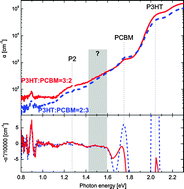Sub-bandgap absorption in organic solar cells: experiment and theory
Abstract
Most high-performance organic solar cells involve bulk-heterojunctions in order to increase the active donor–acceptor interface area. The power conversion efficiency depends critically on the nano-morphology of the blend and the interface. Spectroscopy of the sub-bandgap region, i.e., below the bulk absorption of the individual components, provides unique opportunities to study interface-related properties. We present absorption measurements in the sub-bandgap region of bulk heterojunctions made of poly(3-hexylthiophene-2,5-diyl) as an

- This article is part of the themed collection: Charge transfer: experiment, theory and computation

 Please wait while we load your content...
Please wait while we load your content...